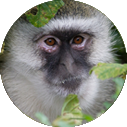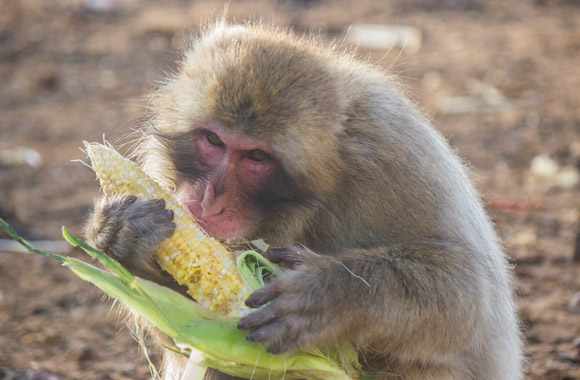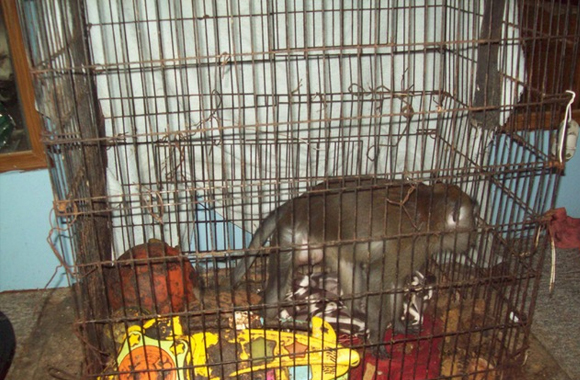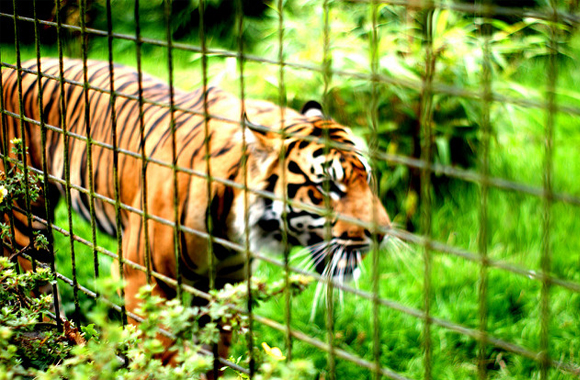About
The vervet is a medium-sized, semi-terrestrial monkey. Equally comfortable on the ground as they are in trees, vervets are diurnal (active in the daytime) and sleep in trees at night. Their lifespan is approximately 30 years.
Vervets are thought to possess the “rudiments of language”: vocal communication through an intricate system of alarm calls that vary greatly depending on the different types of threats to the community. For example, there are distinct predator-specific calls to warn of invading leopards, snakes, and eagles. These unique calls help vervets determine not only where the danger is, but also how to best escape. For example, if a leopard alarm call is raised, vervets may run into trees to escape this terrestrial predator. If an eagle alarm call is raised, vervets may instead look up or run under a bush to avoid an aerial attack.
Vervets spend several hours per day grooming, removing parasites, dirt, or other materials from each other’s fur. Dominant individuals get the most grooming. The hierarchical system also controls feeding, mating, fighting, friendships, and even survival. Young vervets chase one another, wrestle, tumble, and play “king-of-the-castle,” taking turns pushing each other off a high perch.
Vervet society is built on complex but stable social groups (known as troops) of between 10 and 50 individuals, largely adult females and their immature offspring. Females remain in their natal groups throughout their entire life, but males will transfer troops at least once following puberty. Changing troops can be dangerous; the young males may encounter predators without the protection of their troop, and new troops may not accept them. There is a strict social hierarchy among troop members; a mother’s social standing predetermines her offspring’s, and even adults in a family must submit to juveniles of families with higher social status.
Born Free USA’s 175-acre Primate Sanctuary near San Antonio, Texas is home to approximately 475 primates (vervets, baboons, and macaques). While the majority of the inhabitants are macaques, a few vervets also call our sanctuary home. Teddy, an African vervet who was nine months old at the time, arrived at the Sanctuary in June 2015, full of youthful energy. She was bred in a zoo and taken from her mother and sister at four months of age to be sold as a pet. Fortunately, the caregivers charged with interviewing potential buyers understood that a cage in someone’s home was no place for a primate and contacted us. The caregivers purchased Teddy from the zoo and made the long drive to our sanctuary. Teddy now lives a stimulating life in the presence of other monkeys: a far cry from life in a small cage.

Vervets
Status
IUCN Red List classification: Least Concern
CITES status: Appendix II
Endangered Species Act status: N/A
Population
Estimated number remaining in the wild: An exact number is unknown. However, International Union for Conservation of Nature (IUCN) describes vervet populations as often common and abundant, yet very patchily distributed over their extensive geographic range.
Population decline of vervets: The population of vervets is considered to be stable, but may be in decline.
Location
Vervets live in eastern and southern Africa, ranging from the southern Cape to Sudan and Senegal. They prefer to live along wooded riverbanks, although the species is highly adaptable and can survive in a variety of habitats, including open and acacia woodlands, humid rainforests, semi-desert environments, and swamps.
Size
The vervet is a medium-sized, semi-terrestrial monkey. Vervets are typically 11-26 inches long and weigh 7-17 pounds.
Fun Fact
Vervets have four confirmed predators: leopards, eagles, pythons, and baboons. Vervets have acoustically distinct alarm calls for each of these predators, which vervet babies learn to make by observing their elders.
Related Campaigns
Latest News and Work
March 05, 2018
Born Free USA's Primate Sanctuary
At our primate sanctuary – one of the largest in the United States – our mission is to provide monkeys as high a quality of life as we can. The 175-acre sanctuary, located in south Texas, provides a safe, permanent home to hundreds of monkeys, many rescued from abuse in roadside zoos or as pets in private homes or retired from animal experimentation.
MEET THE MONKEYS

